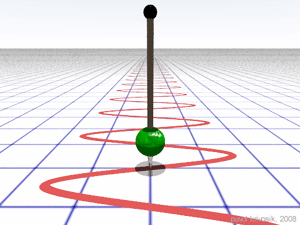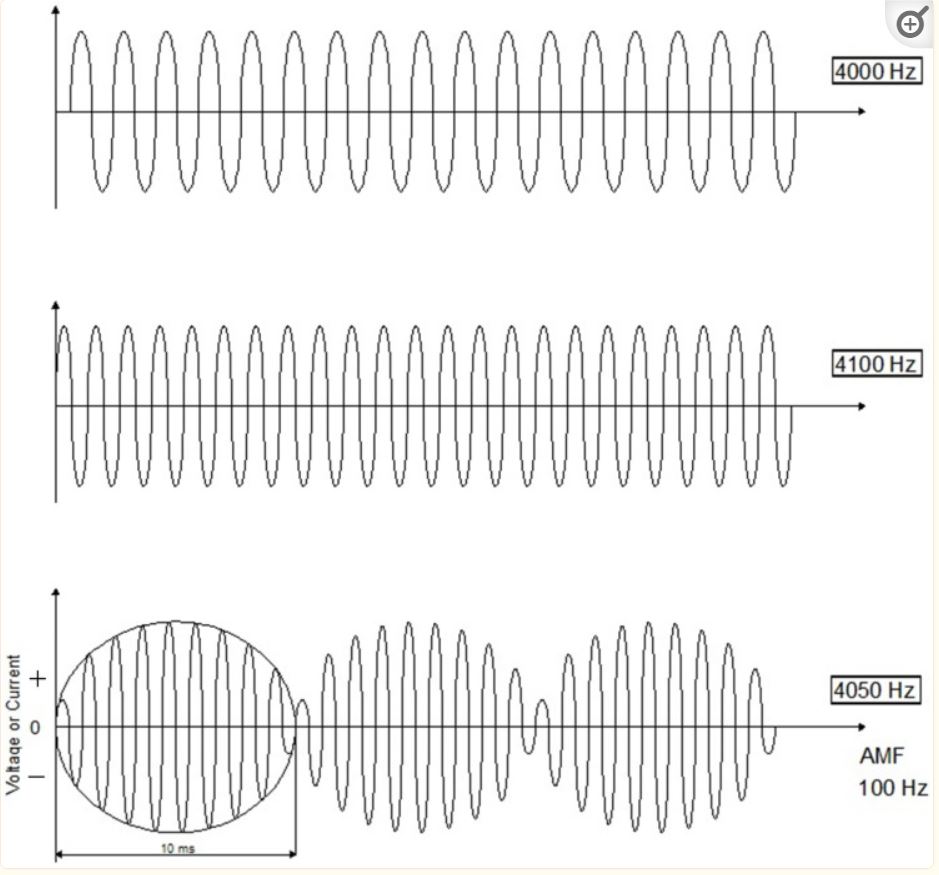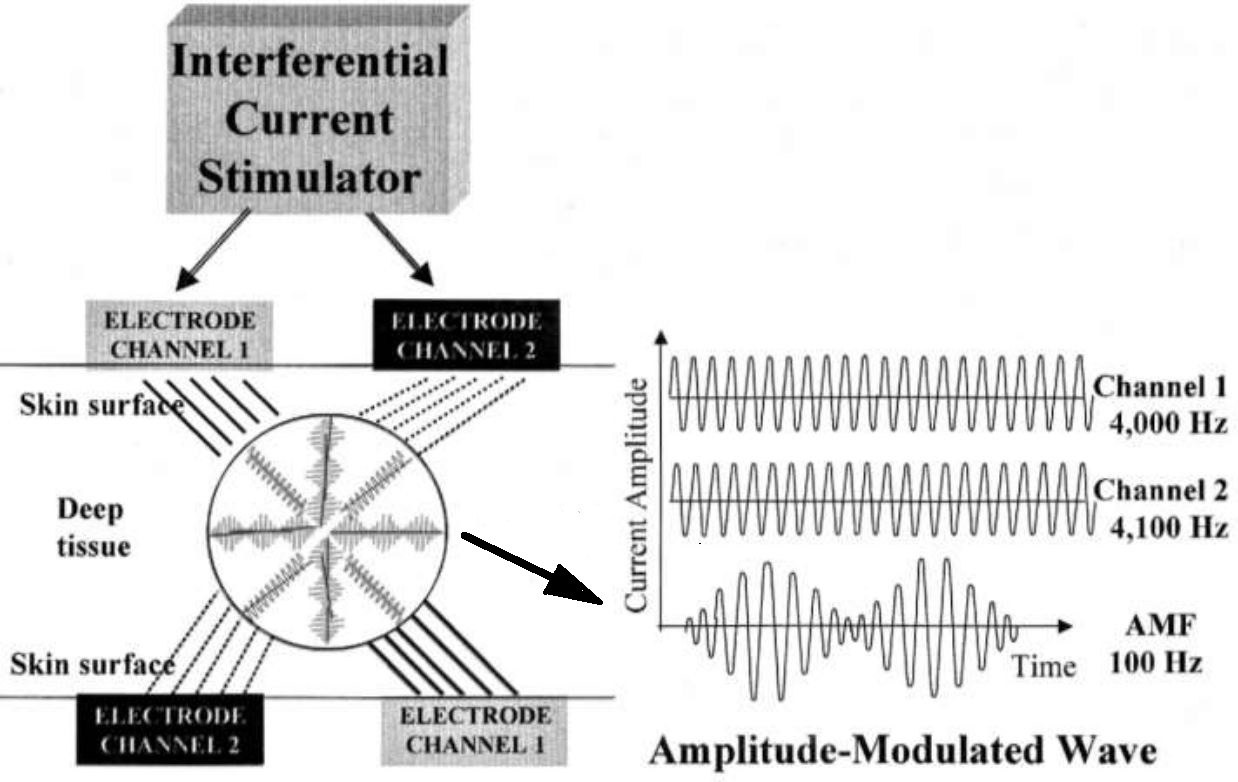Interferential Therapy (IFT)
Introduction to Interferential Therapy (IFT)
Interferential Therapy (IFT) was introduced in the early 1950s by Dr. Hans Nemec to address the discomfort associated with low-frequency currents while retaining their therapeutic benefits. IFT regained attention in the 1970s when Melzack and Wall’s research on pain mechanisms demonstrated that stimulating primary afferent neurons could effectively reduce pain.
IFT History :

IFT Description
IFT involves applying alternating medium-frequency electrical currents through the skin. These currents interact to create low-frequency currents within body tissues, which are used for therapeutic purposes. This process, known as Interferential Current (IFC) or Nemec’s Current, is widely used to relieve pain, improve circulation, and enhance the healing process.
What is Frequency?
Frequency [f] is the number of cycles or oscillations that occur in a given time period. In the context of waves, such as sound waves, light waves, or alternating current (AC), frequency refers to how often the wave repeats itself over a second. It is measured in Hertz (Hz), where 1 Hz is equal to one cycle per second.

Formula of Frequency
The basic formula to calculate frequency is: f = 1/T
Where:
- f is the frequency (in Hertz, Hz)
- T is the period, which is the time it takes to complete one cycle (in seconds, s)
What is Medium Frequency?
Medium Frequency refers to an electrical frequency range between 1,000 Hz (1 kHz) and 10,000 Hz (10 kHz).
Advantages of Medium Frequency:
- Lower Skin Resistance: Medium-frequency currents encounter less skin resistance (impedance), making them more comfortable than low-frequency currents. The aim of crossing two medium-frequency alternating currents is to utilize the concept that the skin offers little ohmic resistance to the passage of medium frequencies (typically two digits), whereas direct currents and low frequencies encounter very high resistance (between 2,000 and 4,000 ohms).
-
- Formula: Z = 1/2πfC, where:
- Z = impedance in ohms
- f = frequency in hertz
- C = capacitance of skin in microfarads
-
- Deeper Penetration: These currents allow for more tolerable and effective penetration through the skin.
Human Body Electrical Resistance
The human body's electrical resistance can vary between 1,000 ohms and a maximum of 100,000 ohms under different conditions.
Characteristics of Interferential Current (IFC)
Interferential Current (IFC) is produced by two medium-frequency currents, known as carrier waves, designed for deeper tissue penetration and the generation of interferential currents.
- Current A (f1): This intrinsic or carrier frequency is set on the machine, typically at 4,000 Hz (2,000 Hz and 6,000 Hz are also options).
- Current B (f2): This current has the same amplitude as f1 but a slightly higher frequency, ranging from 4,001 Hz to 4,150 Hz. Allowing f2 to "swing" within a frequency range helps prevent accommodation and habituation.
- Beat Frequency (F): The difference between f2 and f1 creates the beat frequency, which ranges from 1 Hz to 150 Hz. The amplitude of this beat frequency is not constant.
Principle of Amplitude Modulated Frequency (AMF)
Amplitude Modulated Frequency (AMF) refers to the frequency at which the current's amplitude is modulated. In IFC, this modulation occurs due to the interference of two medium-frequency currents.
Principles:
- Constructive Interference: When two sinusoidal waves are in phase, they supplement each other.
- Destructive Interference: When two waves differ by ½ a wavelength, they cancel each other out.
Blending of waves through constructive and destructive interference produces a beat frequency, also known as Amplitude Modulated Frequency (AMF).
Example:
- Two medium-frequency currents:
- Circuit A = 4,000 Hz
- Circuit B = 4,100 Hz
- When these currents cross over in the tissues, a new beat frequency current appears with an amplitude modulation of 100 Hz.
- Carrier Frequency: (F1 + F2) / 2 = (4,000 + 4,100) / 2 = 4,050 Hz
- Beat Frequency / AMF: F1 - F2 = 4,000 - 4,100 = 100 Hz
- When the frequency of the second channel relative to the constant frequency of the first modifies, it is possible to produce a range of beat frequencies deep in the patient's tissues.


Spectrum
The time and pattern of modulation, known as the spectrum, are adjusted to:
- Reduce nerve adaptation.
- Allow stimulation of a greater range of excitable tissues.
Variable Beat Frequency Examples:
- 0 to 5 Hz: Stimulates sympathetic nerves
- 5 to 10 Hz: Stimulates parasympathetic nerves
- 10 to 50 Hz: Stimulates motor nerves
- 50 to 90 Hz: Produces sedative and spasmolytic effects
- 90 to 100 Hz: Produces analgesic or pain-relief effects
Conclusion
IFC has shown significant analgesic effects in patients with neck pain, low back pain, knee osteoarthritis, and post-operative knee pain. Clinical decisions regarding the use of IFC and its parameters should be based on scientific evidence.
At our clinic, we are proud to offer Interferential Current (IFC) therapy using carefully calibrated equipment to ensure the best possible results for your treatment. This advanced therapy is highly effective in managing pain, improving circulation, and accelerating the healing process.
Our commitment to precise calibration means you receive the most accurate and effective treatment, tailored specifically to your needs.